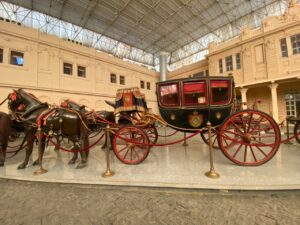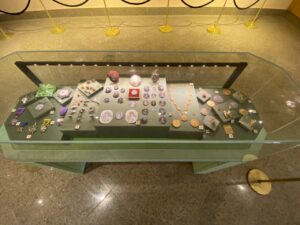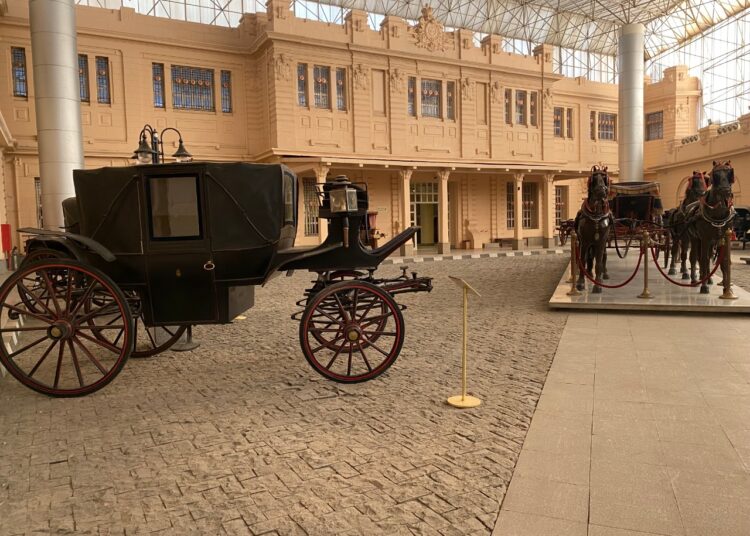Streets are empty except for carriages. No noise except for the sound of horseshoes. Beautiful people with chic attire ride inside the carriages, open or covered. So it was in Cairo during the monarchy. This atmosphere can be felt on entering the Royal Carriage Museum in the Cairo district of Boulaq.
It is a unique place with unmatched exhibits. Since its establishment by Khedive Ismail (1863-1879), it served as a place to preserve the cultural heritage of the royal carriages. It was equipped by successive royal rulers with experts, vets and skilled workers before it was converted into a museum after the July 1952 Revolution.
“This museum is the fifth in the world related to royal carriages, after those in France, Austria, Russia and England,” museum director Ahmed el-Sabbagh told the Egyptian Mail. “It is the only one in the region,” he added.
Inside there is a replica of an Egyptian street of the early 20th century. A huge rectangular mural in white and black is the first thing you see featuring a parade in a street in downtown Cairo celebrating the opening of parliament in 1942.
Facing the mural are many carriages located on the left and right as if they were joining the parade in the mural.
Of them is the royal carriage of Farouk, which appears in the mural. Called an alay (Turkish word for ‘regiment’), this vehicle was a gift from Emperor Napoleon III and his wife Empress Eugenie to Khedive Ismail on the occasion of the opening of the Suez Canal in 1869. Characterised by fine workmanship and elaborate decoration, it bears the royal insignia, the flag of Egypt and the crown.
This four-wheeled, enclosed ceremonial carriage has two bench seats facing each other and an elevated front seat for the coachman. It was pulled by eight horses headed by a ninth horse for the guide.
“All the displayed carriages were gifts to Khedive Ismail and his successors, mainly from France and England,” el-Sabbagh said.
A tonneau was used by King Fouad (1917-1936) in the palace gardens and during hunting trips. It is a small two-wheeled, convertible with a semi-circular wooden leather-covered seat. At the rear is a cylindrical bamboo basket used for sticks and spears. It was pulled by two horses and driven by a single coachman.
One may wonder, when princesses want to have a picnic, do they have a special carriage? Of course. The coupé is a four-wheeled carriage with enclosed seats and an elevated outside seat for the coachman. It was pulled by a pair of horses and driven by two coachmen.
The young princesses use the small pannier, a light carriage with basket-work sides for leisurely rides in the palace gardens. It was pulled by a pair of little horses and driven by a single driver. It is fitted with a canopy.
“The museum also showcases paintings and accessories,” el-Sabbagh added.
On display is a life-size oil painting of Princess Fawzia, daughter of King Fouad. She is wearing an evening gown, a crown, and the shabka (the wedding jewellery set) consisting of Arpels and van Cleef earrings and a necklace presented to her by the then Crown Prince of Iran, Mohammed Reza Pahlavi.
Various accessories are also on display. The gold-plated brooch made out of two pieces in the shape of a horse’s head and the pair of earrings inlaid with semi-precious stones are distinctive pieces. There is a collection of cufflinks ornamented with drawings of birds and animals.
Don’t miss to see the golden brooch in the form of a donkey, inlaid with red coral gemstone.
The museum showcases the footman’s livery worn by the one who used to run alongside the carriage during official processions. The footman was responsible for preparing the carriage, guarding it and clearing the way with a bamboo stick by day and holding out a torch at night.
A collection of saddles includes a small blue one for King Farouk when he was a child. There are a number of rare oil paintings including the equestrian portrait of Mohamed Ali Pasha (1805-1848). Another shows Princess Faika, the adopted daughter of Khedive Ismail, also on a horseback. It was signed by Armenian artist Oskan Chimchidian in 1931.
The Royal Carriage Museum is at 82, July 26th Street, Boulak. Tickets cost LE100 for foreigners and LE30 for Egyptians. It is open daily from 9am to 5pm.











Discussion about this post